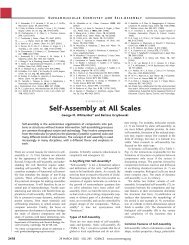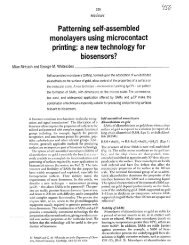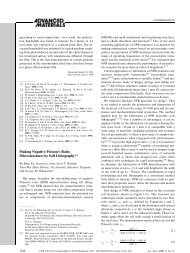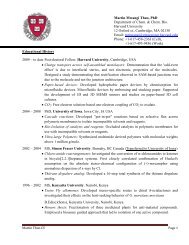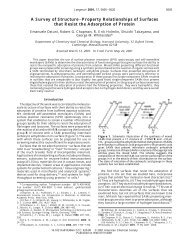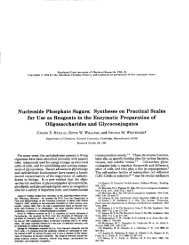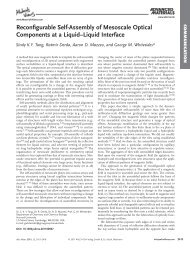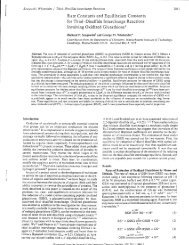Self-Assembled Monolayers of Thiolates on Metals as - Whitesides ...
Self-Assembled Monolayers of Thiolates on Metals as - Whitesides ...
Self-Assembled Monolayers of Thiolates on Metals as - Whitesides ...
You also want an ePaper? Increase the reach of your titles
YUMPU automatically turns print PDFs into web optimized ePapers that Google loves.
1124 Chemical Reviews, 2005, Vol. 105, No. 4 Love et al.<br />
are critical for the development <str<strong>on</strong>g>of</str<strong>on</strong>g> surfaces that<br />
present the large, complex ligands and molecules<br />
needed for biology and biochemistry. The synthesis<br />
<str<strong>on</strong>g>of</str<strong>on</strong>g> functi<strong>on</strong>alized thiols is usually laborious and<br />
difficult even for “simple” molecules, and for SAMs<br />
comprising alkanethiols linked to a peptide, protein,<br />
carbohydrate, or other biomolecules, synthesis can<br />
provide a major challenge. Many <str<strong>on</strong>g>of</str<strong>on</strong>g> the strategies<br />
adopted for modifying SAMs after their formati<strong>on</strong><br />
derive from precedents established in the 1970s and<br />
early 1980s for functi<strong>on</strong>alizing organic films supported<br />
<strong>on</strong> electrodes used for electrochemistry 344 and<br />
<strong>on</strong> solid-ph<strong>as</strong>e materials used for chromatography. 345<br />
Some <str<strong>on</strong>g>of</str<strong>on</strong>g> the methods developed for those systems,<br />
such <strong>as</strong> amide-b<strong>on</strong>d formati<strong>on</strong> (secti<strong>on</strong> 5.2.1) and<br />
n<strong>on</strong>specific adsorpti<strong>on</strong> <str<strong>on</strong>g>of</str<strong>on</strong>g> polymers (secti<strong>on</strong> 5.3),<br />
remain important techniques for modifying SAMs.<br />
Modificati<strong>on</strong> <str<strong>on</strong>g>of</str<strong>on</strong>g> the exposed surface <str<strong>on</strong>g>of</str<strong>on</strong>g> a SAM after<br />
formati<strong>on</strong> <str<strong>on</strong>g>of</str<strong>on</strong>g>fers four advantages: (1) it uses comm<strong>on</strong><br />
synthetic procedures and thus simplifies the preparati<strong>on</strong><br />
<str<strong>on</strong>g>of</str<strong>on</strong>g> functi<strong>on</strong>alized surfaces (secti<strong>on</strong> 5.2); (2) it<br />
enables the incorporati<strong>on</strong> <str<strong>on</strong>g>of</str<strong>on</strong>g> ligands into SAMs that<br />
are not compatible with thiols or the synthetic<br />
methods for preparing them; (3) it can generate<br />
multiple samples with different types <str<strong>on</strong>g>of</str<strong>on</strong>g> ligands in a<br />
short period <str<strong>on</strong>g>of</str<strong>on</strong>g> time (because the SAMs are e<strong>as</strong>y to<br />
prepare); and (4) it preserves the ordered underlying<br />
structure <str<strong>on</strong>g>of</str<strong>on</strong>g> the SAM. An important ec<strong>on</strong>omic advantage<br />
<str<strong>on</strong>g>of</str<strong>on</strong>g> modifying the SAM after formati<strong>on</strong> is that<br />
the amount <str<strong>on</strong>g>of</str<strong>on</strong>g> ligand required for immobilizati<strong>on</strong> is<br />
very small (




